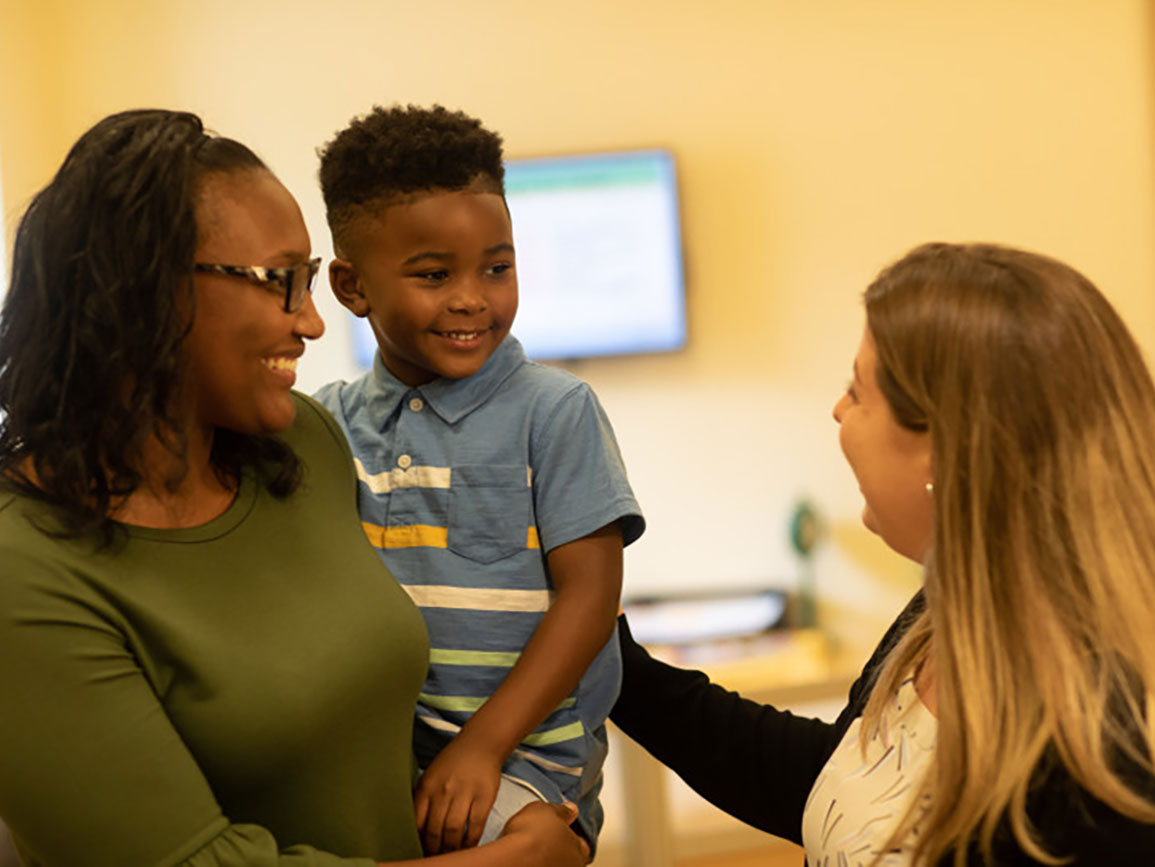At Bright Horizons, we recognize that families play a powerful role in determining the best care and education for their child. Families are partners who are respected, valued, and heard. Additionally we believe that:
- Families are a child’s most important teachers. Family-child interactions are the fundamental basis of the child’s early education and development.
- Families are experts on their own child. Early childhood professionals are knowledgeable about child development, children in general, and individual child behavior within the center environment, but parents know their own child.
- Parents and families are all different. There are many “right” ways to parent. We respect all values, cultures, and beliefs. We work very hard to create “places of belonging,” where each family is valued and has a voice.
In other words, positive parent-teacher relationships matter. They don’t come by chance, but by intention from all parties. This guide offers practical advice on:
- Cultivating Positive Parent-Teacher Relationships
- Supporting the Classroom Learning Culture
- Having Effective Parent-Teacher Conferences
CULTIVATING POSITIVE PARENT-TEACHER RELATIONSHIPS
Families and teachers can offer the very best for children when they work collaboratively to reach a shared goal. This relationship deeply matters because it affects your satisfaction with the school, as well as your child’s feelings about learning. Take a proactive approach to developing this partnership with the following ideas:
Understand communication patterns. Talk with your child’s teacher early in your relationship to learn about their preferred ways to communicate. Teachers often use multiple strategies, such as newsletters, daily written or digital updates, or casual conversations. Drop-off and pick-up times are often busy for both parents and teachers, but try to touch base every day, even if it’s just a quick hello or goodbye. Share helpful information about your family and child, such as changes in your schedule or situation. Don’t be afraid to ask questions or share your concerns. Setting up a respectful, open relationship from the beginning lays the foundation for these conversations. Ask for a phone call or meeting if you need to talk for more than a few minutes. Teachers really do want to communicate with parents, but their attention throughout the day is focused on their interactions with your child. Scheduling a time outside of class is your best bet for a more relaxed, thoughtful exchange.
Develop understanding. Successful family-teacher relationships depend on several factors: mutual respect, common goals, realistic expectations, teamwork, defined roles and responsibilities, and shared decision-making. It’s normal to occasionally disagree over some aspect of your child’s care. Work with your child’s teacher to understand each other’s perspective, reach an agreement, and create plans for the future.
Offer appreciation. Teachers want to make a difference in the lives of children and families, and work hard to make “joyful places for childhood.” Give back to your teacher by expressing gratitude. It could be as simple as a casual verbal or written thank you, or the occasional drawing or picture from your child.
SUPPORTING THE CLASSROOM LEARNING CULTURE
Numerous studies demonstrate that student success is directly tied to family involvement, but what does family involvement actually look like? Every family is different, with different needs, interests, skills, and limitations. A few ideas for family involvement:
- Read to your child every day if possible. This one simple act can have a profound effect on children’s learning.
- Find out about the learning taking place in the classroom. What is your child interested in? What questions does he or she have? Read communication from the teacher, and take time to look at the projects, documentation panels, and materials in the classroom.
- Understand the schedule and classroom expectations. Hand in paperwork and respond to the teacher’s questions or requests in a timely manner.
- Offer your skills or expertise. Lead a cooking activity or art project with the children, or donate a few hours of your time when the school asks for volunteers.
- Attend events such as a class picnic, field trip, or celebration when possible. These events often happen in the evening, making them more accessible to working parents.
- Join parent committees and contribute your voice.
HAVING EFFECTIVE PARENT-TEACHER CONFERENCES
The family conference is a time for teachers and families to share observations and perspectives and create an accurate picture of the child’s development. During the conference, expect to share observations, celebrate milestones, speak in-depth about progress and concerns, and plan future goals. Try the following ideas to get the most out of this meeting:
Come prepared. Talk with your child’s teacher frequently throughout the year so you have a positive rapport already established. Share questions and concerns as they arise so that neither one of you are surprised at the conference. Let the teacher know if there are specific things you want to focus on. Pay attention to lesson plans, newsletters, documentation panels, and other communication so you know about the teacher’s philosophy and curriculum.
Focus on sharing information, strengthening relationships, discussing concerns, and celebrating your child’s growth. Ask questions and listen to the teacher’s perspective. What you see at home isn’t necessarily what the teacher sees in the classroom and vice versa. Comparing notes offers valuable new insight.
Create goals together. Talk with your child’s teacher about the next steps in your child’s growth. Be open-minded and be sure to ask if you don’t understand something.
ADDITIONAL RESOURCES ON PARENT-TEACHER PARTNERSHIPS
- Explore a whole list of questions to ask during your next parent-teacher conference.
- Learn about the Horizons Teacher Degree Program that gives teachers the ability to earn their college degrees for free and hear from graduates of the program.





